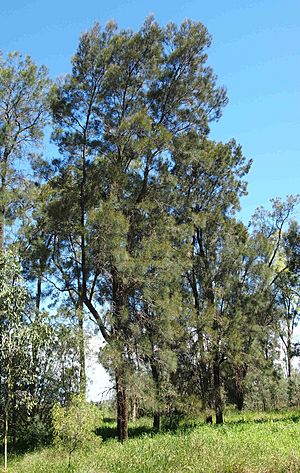Belah facts for kids
Quick facts for kids Belah |
|
|---|---|
 |
|
| Scientific classification | |
| Genus: |
Casuarina
|
| Species: |
cristata
|
The Casuarina cristata is a special Australian tree. It belongs to the sheoak family, called Casuarinaceae. Most people know it as the belah tree. You can find it growing across the inland parts of eastern Australia.
Contents
What is the Belah Tree?
The belah tree is a type of sheoak. It's known for its unique look. This tree is an important part of the Australian landscape. It helps many animals and other plants.
How the Belah Got Its Name
A Dutch scientist named Friedrich Anton Wilhelm Miquel first described the belah tree in 1848. The tree still has the same scientific name he gave it. Local Aboriginal people have their own names for it. For example, in the Yuwaalaraay language, it's called Muurrgu or Murrgu. The name "belah" itself comes from an Aboriginal word. Other common names for it include scaly-barked casuarina and scrub she-oak.
What Does a Belah Tree Look Like?
Belah trees can grow quite tall. They usually reach about 10 to 20 meters (33 to 66 feet) high. Their main trunk can be about 1 meter (3 feet) wide.
Bark and Branches
The tree has dark, greyish-brown bark. This bark often looks scaly. Its branches hang down, giving the tree a graceful, weeping look.
Tiny Leaves
What look like long, thin leaves are actually special branchlets. The tree's true leaves are very tiny scales. You can find these scales along the branchlets.
Where Do Belah Trees Grow?
Belah trees grow in a specific area of Australia. Their range stretches from Clermont in central Queensland. It goes south all the way to Temora in southern New South Wales.
Its Home Environment
The belah tree is a key part of a special forest type. This forest is called the Brigalow ecological community. It's found in inland New South Wales and Queensland. Sadly, this community is now endangered.
Other Plants That Grow With Belah
In these forests, belah trees are often the main trees. They grow alongside other trees like brigalow (Acacia harpophylla). You might also see black gidyea (A. argyrodendron) and bimble box (Eucalyptus populnea). Smaller trees like wilga (Geijera parviflora) also share this habitat. These trees usually grow on clay plains. On soils with limestone, belah trees might have a thick layer of smaller plants underneath. These can include pearl bluebush (Maireana sedifolia).
How Belah Trees Reproduce
Belah trees have a cool way of making new trees. They can grow new shoots directly from their root system. This means a single tree can create a whole group of new trees. These groups are like clones of the original. New belah seedlings usually only appear after a lot of rain.

